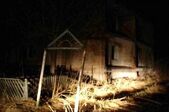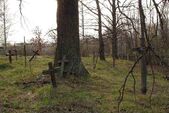|
The cans in the market suddenly stopped having labels. I don't think it was because they ran out of paper.
This page's sources are incomplete, nonexistent or unreliable. You can help the Chernobyl Wiki improve by expanding it.
|
[RU: Дороги и лесных районах в зоне отчуждения], [DE: Straßen und Waldgebiete in der Sperrzone]
Most of the 30-km Exclusion Zone is forests and marshes, and much of the area's villages that were evacuated but not buried have been overgrown.
Villages[]

A large portion of the villages within thirty or forty kilometers of Chernobyl were evacuated and often demolished to be buried as radioactive waste. Initially after the accident, during the evacuation, people from villages would go to the soldiers and police officers - one would give some vodka so that his village would be taken off the list, while another might give some vodka so that his village would be put on the list because he'd already been promised an apartment in Minsk or Kiev. Today, several villages that were left intact are inhabited by elderly people who returned to their homes. Sometimes families with young children also live illegally in the area, ignoring the ban on fishing and forestry; they eat contaminated fish and berries, and burn radioactive wood in their stoves.
Roadways[]

The condition of the roads in the contaminated zone varies wildly. Some are in very good condition and are easy to travel on (left).

Sometimes the roads are in bad condition or lead nowhere, so they are blocked off to prevent travelers in the area from getting lost (right).
Forests and Wildlife[]
History[]
In 1986, when the reactor blew, only 20% of what is now the Exclusion Zone was forested. In the late 1940's, after WWII, there was a mass of deforestation in the Pripyat Marshes in order to make room for more Kolkhoz farms (in Russian: колхоз). On top of this there were no regulations on hunting and wolves were readily poached because they threatened livestock, for their fur, or just for the sport of killing wolves, which lead to a rapid decline of the species in the area, almost to the point of driving wolves in Ukraine extinct, and their loss of natural habitat did not help; Ukraine has 40% of the world's supply of black earth, the highest of any one area on the planet, which made it an ideal place for farming.

A house, smothered by plants.
The New Wormwood Forest[]
Today, more than 70% of the Exclusion Zone is forested because of the lack of human influence. The Exclusion Zone has become something of a natural wildlife reserve because the forests returned after the catastrophe, rapidly swallowing much of the manufactured areas. Today most things that were not paved over are gone, save for some villages where a few of the residents returned, and a good 50% of what was paved has been devoured by the green as well, making the Zone look more like it did in the early 1900's.
Passing Through The Area[]
If you are a tourist at Chernobyl, you may see these things in the areas less famous than Pripyat or the power plant itself:











